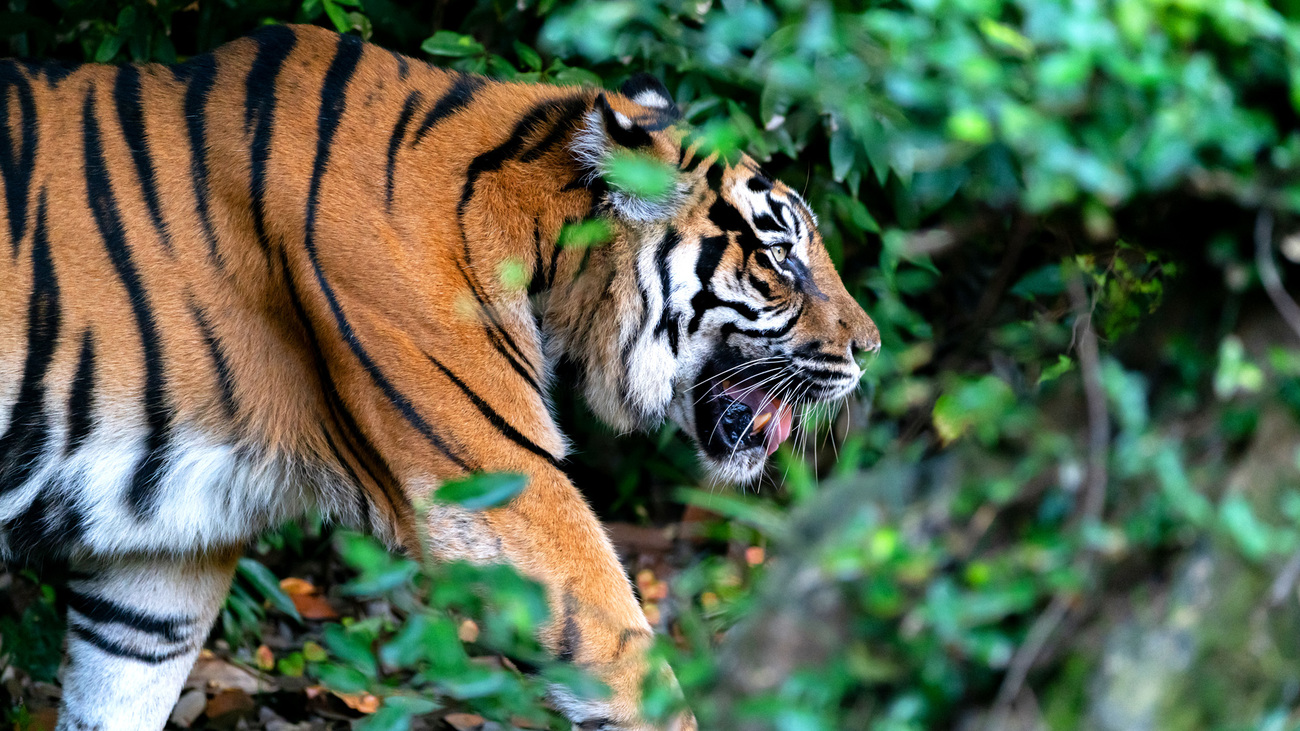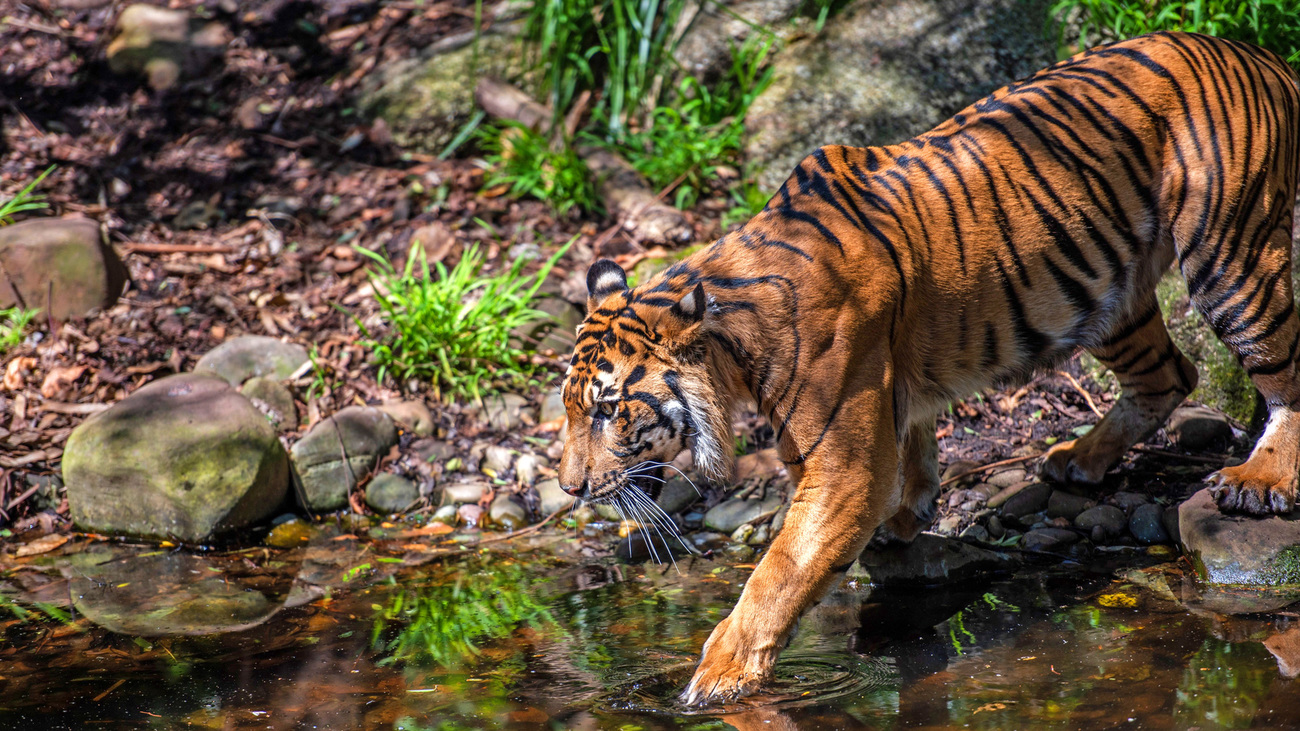Sumatran tigers
What is a Sumatran tiger?
The Sumatran tiger is a population of the Sunda Island tiger subspecies found exclusively on the Indonesian island of Sumatra. With only 600 individuals remaining in the wild, Sumatran tigers are elusive animals that conservationists are desperately trying to protect.
Though they are big cats, Sumatran tigers are the smallest tigers in the world. Male adults weigh about 120 kilograms (260 pounds), while females weigh about 90 kilograms (200 pounds). From head to tail, males are about 2.5 meters (eight feet) long. Females are about 30 centimeters (one foot) shorter.
They also have the darkest coat and the thinnest stripes of all tigers, two adaptations that developed over time to help them blend into the deep forests in which they live. As they slink through the trees, they become indistinguishable from the trunks around them. Just like a human’s fingerprints, each Sumatran tiger has its own distinct markings, though you’d have to look very closely to tell them apart.
As solitary animals, Sumatran tigers typically only come together to mate and reproduce. They reach maturity at around three or four years old, and their breeding season lasts all year long. A female usually gives birth to a litter of two to three cubs and raises them without the help of the male or other females.
Sumatran tigers are apex predators, meaning the health of their population is indicative of the health of their ecosystem overall. They sit at the top of the food chain. These carnivorous cats can hunt large animals as prey, including cattle, baby elephants, and tapir. The majority of their diet is made up of wild pigs and deer, though they also hunt some smaller animals like monkeys, fish, and birds.
On the island of Sumatra, these tigers inhabit tropical sub-mountain and mountain forests, freshwater swamp forests, and peat swamps. They are the last remaining population of Sunda Island tigers, as the Balinese and Javan tigers have both already gone extinct. Sumatran tigers are critically endangered, with a high risk of also becoming extinct in the wild.
What is a Sumatran tiger’s scientific name?
The scientific name for a Sumatran tiger is Panthera tigris sondaica, as it is a population of the Sunda Island tiger subspecies.
Are Sumatran tigers endangered?
Yes, according to the IUCN, Sumatran tigers are critically endangered, with fewer than 600 mature individuals remaining in the wild.
They have held this status for more than two decades, and population numbers are still consistently declining. Unfortunately, this is mostly driven by hunting, including retaliatory killings following conflict with locals. Between 2001 and 2016, more than eight tigers were killed each year for this reason. Rapid habitat loss has also caused huge problems for tigers on Sumatra. As their populations become more fragmented, it becomes impossible for them to reproduce at a rate that ensures their survival.
Where do Sumatran tigers live?
Sumatran tigers live on the Indonesian island of Sumatra. More specifically, they inhabit tropical sub-mountain and mountain forests, as well as freshwater swamp forests and peat swamps.
Threats
These critically endangered animals face a number of threats, from deforestation to poaching. Let’s look at them in detail.

Poaching
Even in designated protected zones on the island of Sumatra, tigers are still under threat from poaching. They are mostly hunted for their bones and teeth, though poachers also target them for their skin. Tiger bones are used by a minority of wealthy people in China to make tea, in the belief that it will impart the characteristics of a tiger upon the drinker. Their teeth are also in demand for jewelry making.
A study found that, between 2000 and 2018, Indonesia was the world’s third-largest supplier of tiger parts, with an estimated 266 Sumatran tigers entering the illegal wildlife trade during that time. Between 2012 and 2016, the number of poachers that were caught in Indonesia increased seven-fold. While it’s good that traffickers are being stopped by authorities, it does indicate that a rampant network of illicit trade still exists.
Habitat loss
Nearly 20% of Sumatran tiger habitat was cleared for palm oil production between 2000 and 2012. Palm trees are in high demand for their oil, which is now the most widely-used vegetable oil in the world, present in everything from chocolate to cosmetics.
Losing such vast amounts of forest in such a short amount of time has left tiger populations vulnerable to fragmentation. Though tigers are solitary animals, they still need regular contact with other members of the species to mate and produce healthy offspring with a wide genetic pool.
Human-wildlife conflict
Along with poaching and trafficking, conflict between humans and tigers remains one of the biggest threats to the survival of their population. Between 2000 and 2016, 130 tigers were killed due to conflict with local inhabitants. As agricultural land expands more and more into the tigers’ natural habitat, leaving the cats with less space, the number of these conflicts will only increase.
Declining prey populations
Wild boar is the primary food source for Sumatran tigers. However, the number of wild boar has dramatically dropped in the past few years due to an outbreak of African swine fever (ASF) in Sumatra. It was first reported in China in 2018 and has swiftly made its way across Asia, throwing the delicate food chain of Sumatra into chaos. By 2021, there had been multiple deaths of wild boar from the virus reported from all provinces on the island of Sumatra.
FAQs
With such small numbers of Sumatran tigers left in the wild, they are an elusive animal, and it’s hard to glimpse them in their natural habitat. Here are the facts we do know about Sumatran tigers.
How big are Sumatran tigers?
While they are still large and majestic cats, Sumatran tigers are the smallest type of tiger.
Male adults weigh about 120 kilograms (260 pounds), while female Sumatran tigers weigh about 90 kilograms (200 pounds). From head to tail, males are about 2.5 meters (eight feet) long.

How do Sumatran tigers hunt?
Sumatran tigers are ambush predators, meaning they stalk their prey slowly and quietly before pouncing to make the kill. They can be incredibly fast, reaching speeds of up to 65 kilometers per hour (40 miles per hour), though only for a short time.
Not only are Sumatran tigers carnivores, but they are apex predators, meaning they sit at the very top of the food chain. They hunt at night, under the cover of darkness, and tend to take down about one big kill per week. They’re not picky and will hunt anything from baby elephants and pigs to monkeys and fish.
How long do Sumatran tigers live?
In the wild, Sumatran tigers typically live for about 15 years.
What do Sumatran tigers eat?
These tigers prey on a variety of animals. Wild boar are their number one source of food, but they also eat fish, monkeys, wild boar, tapirs, and deer, among many others.
What do Sumatran tigers look like?
Sumatran tigers are the smallest of all tiger subspecies and have the darkest coats and thinnest stripes. They have a deep red-orange coat with thin black stripes, which helps them blend into the forests where they live. These tigers also tend to have shaggy, long hair around their face and muzzle, giving them a maned look.
What is the Sumatran tiger’s habitat?
Sumatran tigers, as the name suggests, live only on the Indonesian island of Sumatra. They inhabit tropical sub-mountain and mountain forests, as well as freshwater swamp forests and peat swamps.
How many cubs do Sumatran tigers have?
While the litter of female Sumatran tigers can range anywhere from one to six cubs, the average litter size is two to three. Females reach sexual maturity around three to four years of age, males around five.
What are the main threats to Sumatran tigers?
The main threats faced by Sumatran tigers are poaching, conflict with locals, and deforestation.
Despite strict laws and dedicated conservation zones, Sumatran tigers are continually killed by poachers and local farmers. They’re hunted for their bones, teeth, and skin, which are sold illegally on the black market. The increase in human population and agricultural activities, plus the increasing demand for more palm oil, is also destroying more and more tiger habitats each year.
Why are Sumatran tigers important?
Sumatran tigers are apex predators and a keystone species. That means that the health of the tiger population is indicative of the overall health of their ecosystem.
Healthy tiger populations reflect a healthy environment—and, unfortunately, there is not a healthy tiger population in Sumatra at the moment. Ongoing conservation efforts, if successful, won’t only help the tiger populations, but all the flora and fauna on the island.
Our work
IFAW works closely with partners, governments, and local communities to secure a better future for tigers.
In India, we work with the Wildlife Trust of India (WTI) in collaboration with Assam Forest Department to help protect tigers living in Kaziranga National Park. Annual floods displace these animals, forcing tigers in the park to seek out higher ground for safety—often near or within neighbouring communities. Our teams rescue tigers in need and provide them with lifesaving veterinary care.
IFAW-WTI has been working in Central India for over a decade, mitigating human-tiger conflicts, allowing safe passage to moving tigers, reducing human pressures on already fragmented corridors, and integrating stakeholder support in conservation management of tiger habitats. IFAW-WTI has also worked to strengthen protection for these big cats amongst other species by capacity building frontline staff (rangers), providing legal and enforcement assistance to wildlife enforcement agencies, and conducting anti-snare walks in critical tiger habitats.
Through the Greater Manas Landscape Conservation project in Manas National Park, we’re working with communities and governments to recover forests along the India-Bhutan border, which provide key habitats for tigers, among other species. Over the past two decades, IFAW-WTI has helped increase protection to over 700 square kilometres (270 square miles) of tiger habitats with the declaration of the First Addition to Manas National Park in 2016 and Raimona National Park in 2021. These two parks are linked to 3,000 square kilometres (nearly 1,200 square miles) of forests in India and Bhutan that serve as tiger habitats.
In China, IFAW has been supporting stringent domestic enforcement efforts and facilitating international enforcement collaboration to tackle illegal trade of tiger products. Meanwhile, IFAW has been implementing a targeted behavioural change campaign over a decade to shift social norms and reduce demand for tiger products.
In 2018, we helped launch the Coalition to End Wildlife Trafficking Online. As part of the coalition, companies and wildlife experts from around the world came together to develop an approach to reducing wildlife trafficking online. Since then, online technology companies within the coalition have removed or blocked over twelve million online advertisements for endangered or threatened species, including tigers. The AI Guardian of Endangered Species that IFAW jointly developed with Baidu is able to identify images of tiger products with an over 90% accuracy rate, significantly enhancing our capacity to identify and prevent illegal tiger trade online.
We work to protect tigers in the US too. In 2017, we established the Big Cat Sanctuary Alliance (BCSA), a network of sanctuaries that cooperate to ensure that captive tigers have a safe place to go when they are rescued. At the federal policy level, we also worked to pass the Big Cat Public Safety Act. This legislation, signed into law in December 2022, made private ownership of big cats and physical contact between the public and captive big cats illegal. As a result of these combined efforts, since 2003, we’ve rescued 189 captive big cats and placed them in legitimate sanctuaries.

How can you help?
Sumatran tigers are critically endangered and face a range of threats, including poaching for their skin, bones, and teeth, as well as habitat loss due to human agricultural activities and palm oil.